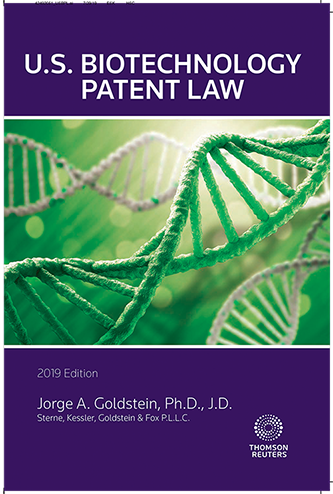U.S. Biotechnology Patent Law, 2019-2020, authored by firm director Jorge A. Goldstein, Ph.D., is an update to the third edition. This book is a highly readable and well-organized desktop companion for practicing attorneys, and patent agents, seeking effortless entry into U.S. case law dealing with patents in modern biotechnology. Using the book’s descriptive subtitles or its double-entry tables, experienced or novice prosecutors, litigators, inside counsel or academicians can readily access any sub-area of the law, understand the legal background, and then find clear descriptions of the most important cases. The book’s focus is on biotechnology cases decided by the Court of Appeals for the Federal Circuit, its predecessor, the Court of Customs and Patent Appeals, the U.S. Supreme Court, and – when relevant – the U.S. Patent & Trademark Office Appeal Boards.
U.S. Biotechnology Patent Law features a contemporary format and feel, in both print and electronic formats. Each important biotech case is prominently highlighted and includes, in order:
- A summary and relevance of the holding;
- Separate patent claims (since the holdings in patent law can only be understood in reference to the claims – Are they methods? Products? What are the exact words and limitations? – the author has separated the involved claims for immediate access.);
- Technology drawings or other facts needed for a clearer understanding; and
- Verbatim citations and quotes from the tribunal.
Throughout the publication, there are comments contained in shaded boxes, allowing the reader to easily distinguish the discussions in the cases from the opinions of the author. These comments include trends in the caselaw, critiques of outlier cases, and attempts to provide unifying themes to the historical and thematic development of the caselaw. Also included are diagrams that, at a glance, provide understanding of a body of caselaw, such as, for example, the development of a drug from early research to a time after approval by the FDA, or a summary of enablement and written description. The comments and diagrams are tabulated at the beginning of the book in a “Table of Comments.”
And, featured at the end of the book are a series of appendices in the form of double-entry tables that provide additional access to the caselaw. For example, if readers look for cases on antibodies across all statutes of the patent law, they find them in the appropriate row; if they want cases dealing with enablement across all scientific areas of biotechnology, they find them in the appropriate column; and if they want only enablement cases on antibodies, they find them in the cell at the intersection.
Highlights of This New Edition
Among the numerous revisions in this updated 2019-2020 edition are the following:
Chapter 3 Eligibility: Continued discussion of the guidance provided by the courts in the area. Updates include discussion of the following cases: Roche v. Cepheid (2018), Natural Alternatives v. Creative Compounds (2019), Athena Diagnostics v. Mayo (2019), and Endo Pharma v. Teva (2019). The author has also added commentary on the emerging rules on the eligibility of biotechnology method claims.
Chapter 6 Written Description: In light of the Supreme Court’s denial of certiorari, the author has reorganized and added new sections on the written description of antibody genuses.
Chapter 9 Novelty: A new Comment has been included to explain the recently-decided Helsinn v. Teva (Fed. Cir. 2019), which, held that, post the AIA of 2012-2013, a secret sale of a claimed product is still a statutory bar to patentability.
Chapter 10 Obviousness: A new introduction to the general analysis of obviousness of biotechnology claims has been added. Also, discussion of UC v. Broad Institute (Fed. Cir. 2018) has been incorporated into the chapter.
Chapter 11 Inventorship: The author has expanded the Comment at 11:4 to clarify the law on the simultaneous conception and reduction to practice of inventions in unpredictable technologies like biotechnology.
Chapter 12 Infringement: Additional case law has been incorporated for discussion of the impact (or not) of an attorney’s mistakes in prosecution, experimental use exception and claim construction of a claimed biological deposit number.interpretation of product-by-process claims for novelty purposes and additional case law discussion regarding The doctrines of inherent and accidental anticipation.
Related Industries
Related Services

Receive insights from the most respected practitioners of IP law, straight to your inbox.
Subscribe for Updates
